BMP4002 Business Law: Report on Key Legal Sources for UK Businesses
VerifiedAdded on 2023/06/08
|8
|2337
|178
Report
AI Summary
This report provides an overview of the key sources of law as they relate to business organizations in the UK. It covers various business structures, including sole traders, general partnerships, limited partnerships, and limited liability partnerships, outlining their essential requirements, advantages, and disadvantages. The report also offers recommendations to IOM Solutions, a sole trader business, suggesting a transition to a limited liability partnership for potential business expansion, highlighting the benefits of separate legal identity and limited liability. The analysis draws upon relevant legal frameworks, such as the Companies Act, Partnership Act, and Limited Liability Partnership Act, to provide a comprehensive understanding of the legal landscape for businesses in the United Kingdom. Desklib provides a platform to access similar solved assignments and past papers.
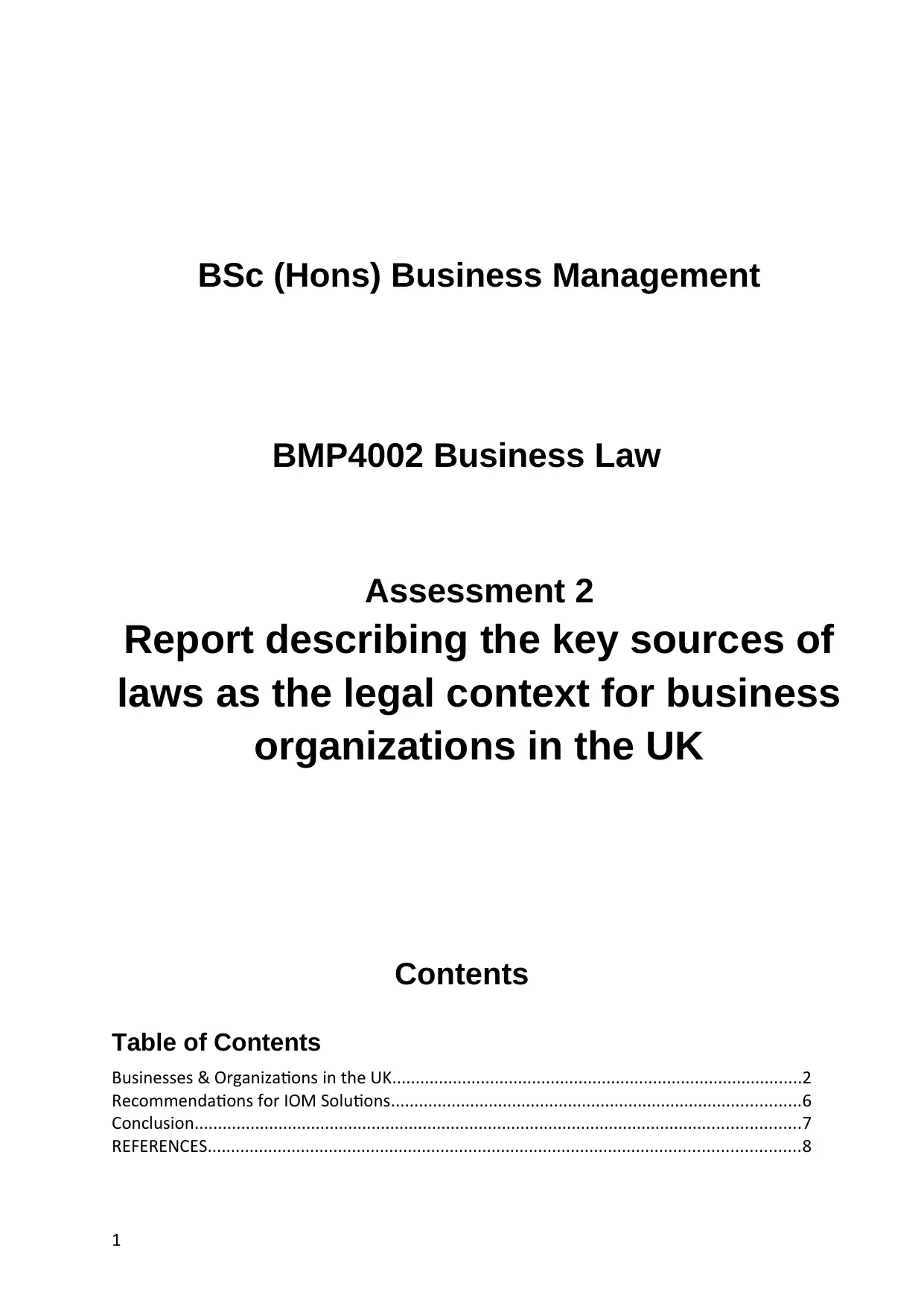
BSc (Hons) Business Management
BMP4002 Business Law
Assessment 2
Report describing the key sources of
laws as the legal context for business
organizations in the UK
Contents
Table of Contents
Businesses & Organizations in the UK........................................................................................2
Recommendations for IOM Solutions........................................................................................6
Conclusion..................................................................................................................................7
REFERENCES...............................................................................................................................8
1
BMP4002 Business Law
Assessment 2
Report describing the key sources of
laws as the legal context for business
organizations in the UK
Contents
Table of Contents
Businesses & Organizations in the UK........................................................................................2
Recommendations for IOM Solutions........................................................................................6
Conclusion..................................................................................................................................7
REFERENCES...............................................................................................................................8
1
Paraphrase This Document
Need a fresh take? Get an instant paraphrase of this document with our AI Paraphraser
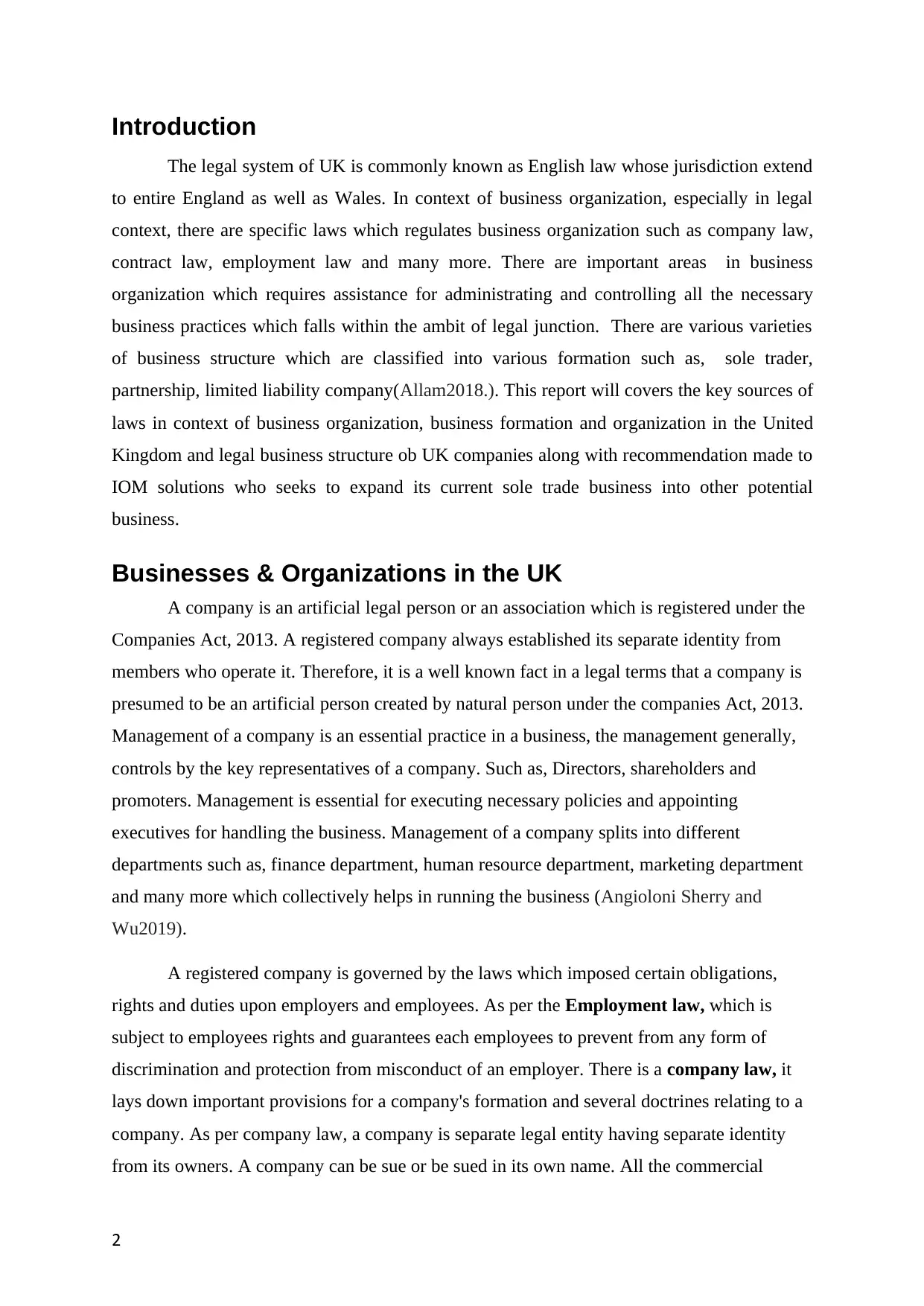
Introduction
The legal system of UK is commonly known as English law whose jurisdiction extend
to entire England as well as Wales. In context of business organization, especially in legal
context, there are specific laws which regulates business organization such as company law,
contract law, employment law and many more. There are important areas in business
organization which requires assistance for administrating and controlling all the necessary
business practices which falls within the ambit of legal junction. There are various varieties
of business structure which are classified into various formation such as, sole trader,
partnership, limited liability company(Allam2018.). This report will covers the key sources of
laws in context of business organization, business formation and organization in the United
Kingdom and legal business structure ob UK companies along with recommendation made to
IOM solutions who seeks to expand its current sole trade business into other potential
business.
Businesses & Organizations in the UK
A company is an artificial legal person or an association which is registered under the
Companies Act, 2013. A registered company always established its separate identity from
members who operate it. Therefore, it is a well known fact in a legal terms that a company is
presumed to be an artificial person created by natural person under the companies Act, 2013.
Management of a company is an essential practice in a business, the management generally,
controls by the key representatives of a company. Such as, Directors, shareholders and
promoters. Management is essential for executing necessary policies and appointing
executives for handling the business. Management of a company splits into different
departments such as, finance department, human resource department, marketing department
and many more which collectively helps in running the business (Angioloni Sherry and
Wu2019).
A registered company is governed by the laws which imposed certain obligations,
rights and duties upon employers and employees. As per the Employment law, which is
subject to employees rights and guarantees each employees to prevent from any form of
discrimination and protection from misconduct of an employer. There is a company law, it
lays down important provisions for a company's formation and several doctrines relating to a
company. As per company law, a company is separate legal entity having separate identity
from its owners. A company can be sue or be sued in its own name. All the commercial
2
The legal system of UK is commonly known as English law whose jurisdiction extend
to entire England as well as Wales. In context of business organization, especially in legal
context, there are specific laws which regulates business organization such as company law,
contract law, employment law and many more. There are important areas in business
organization which requires assistance for administrating and controlling all the necessary
business practices which falls within the ambit of legal junction. There are various varieties
of business structure which are classified into various formation such as, sole trader,
partnership, limited liability company(Allam2018.). This report will covers the key sources of
laws in context of business organization, business formation and organization in the United
Kingdom and legal business structure ob UK companies along with recommendation made to
IOM solutions who seeks to expand its current sole trade business into other potential
business.
Businesses & Organizations in the UK
A company is an artificial legal person or an association which is registered under the
Companies Act, 2013. A registered company always established its separate identity from
members who operate it. Therefore, it is a well known fact in a legal terms that a company is
presumed to be an artificial person created by natural person under the companies Act, 2013.
Management of a company is an essential practice in a business, the management generally,
controls by the key representatives of a company. Such as, Directors, shareholders and
promoters. Management is essential for executing necessary policies and appointing
executives for handling the business. Management of a company splits into different
departments such as, finance department, human resource department, marketing department
and many more which collectively helps in running the business (Angioloni Sherry and
Wu2019).
A registered company is governed by the laws which imposed certain obligations,
rights and duties upon employers and employees. As per the Employment law, which is
subject to employees rights and guarantees each employees to prevent from any form of
discrimination and protection from misconduct of an employer. There is a company law, it
lays down important provisions for a company's formation and several doctrines relating to a
company. As per company law, a company is separate legal entity having separate identity
from its owners. A company can be sue or be sued in its own name. All the commercial
2
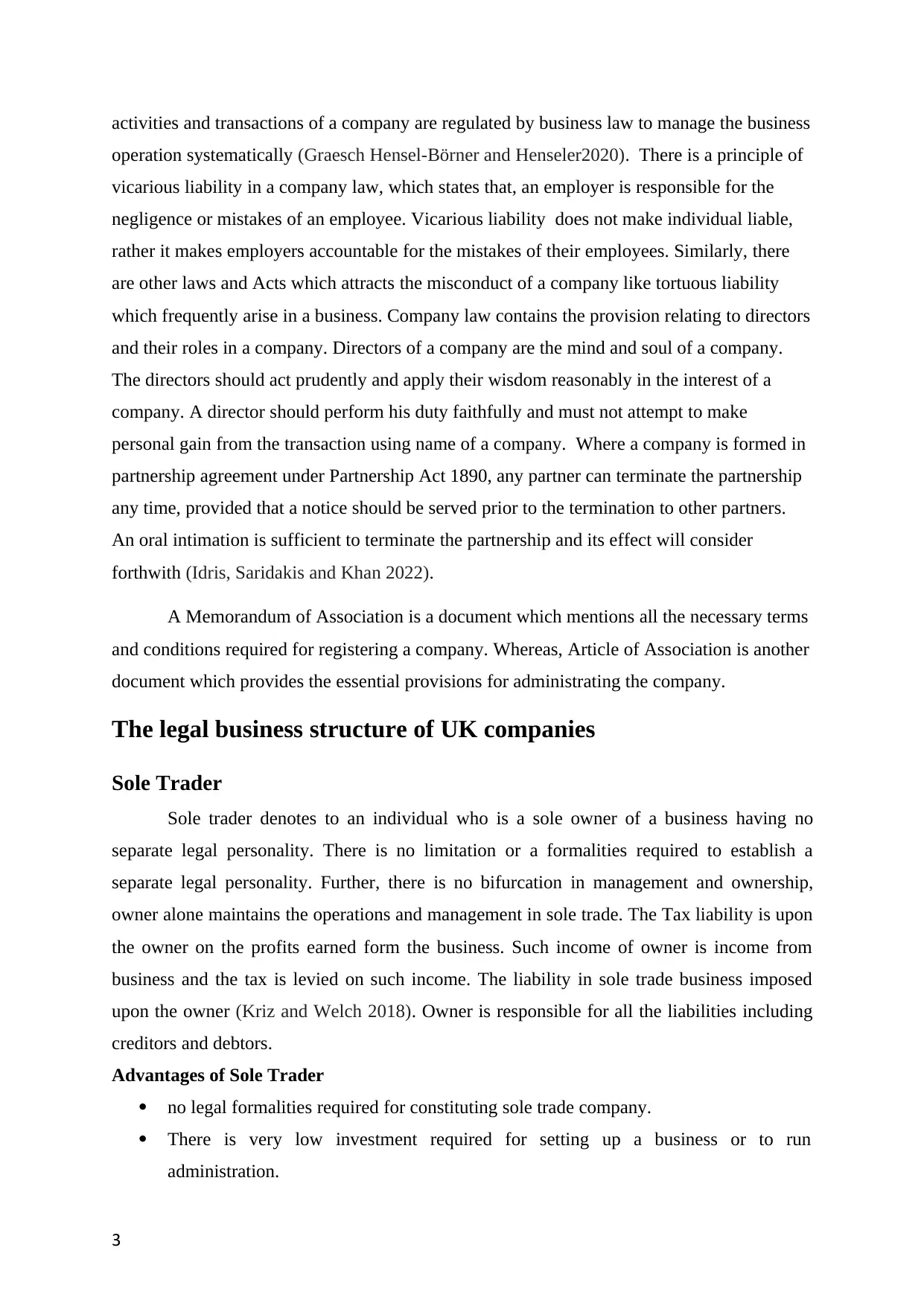
activities and transactions of a company are regulated by business law to manage the business
operation systematically (Graesch Hensel-Börner and Henseler2020). There is a principle of
vicarious liability in a company law, which states that, an employer is responsible for the
negligence or mistakes of an employee. Vicarious liability does not make individual liable,
rather it makes employers accountable for the mistakes of their employees. Similarly, there
are other laws and Acts which attracts the misconduct of a company like tortuous liability
which frequently arise in a business. Company law contains the provision relating to directors
and their roles in a company. Directors of a company are the mind and soul of a company.
The directors should act prudently and apply their wisdom reasonably in the interest of a
company. A director should perform his duty faithfully and must not attempt to make
personal gain from the transaction using name of a company. Where a company is formed in
partnership agreement under Partnership Act 1890, any partner can terminate the partnership
any time, provided that a notice should be served prior to the termination to other partners.
An oral intimation is sufficient to terminate the partnership and its effect will consider
forthwith (Idris, Saridakis and Khan 2022).
A Memorandum of Association is a document which mentions all the necessary terms
and conditions required for registering a company. Whereas, Article of Association is another
document which provides the essential provisions for administrating the company.
The legal business structure of UK companies
Sole Trader
Sole trader denotes to an individual who is a sole owner of a business having no
separate legal personality. There is no limitation or a formalities required to establish a
separate legal personality. Further, there is no bifurcation in management and ownership,
owner alone maintains the operations and management in sole trade. The Tax liability is upon
the owner on the profits earned form the business. Such income of owner is income from
business and the tax is levied on such income. The liability in sole trade business imposed
upon the owner (Kriz and Welch 2018). Owner is responsible for all the liabilities including
creditors and debtors.
Advantages of Sole Trader
no legal formalities required for constituting sole trade company.
There is very low investment required for setting up a business or to run
administration.
3
operation systematically (Graesch Hensel-Börner and Henseler2020). There is a principle of
vicarious liability in a company law, which states that, an employer is responsible for the
negligence or mistakes of an employee. Vicarious liability does not make individual liable,
rather it makes employers accountable for the mistakes of their employees. Similarly, there
are other laws and Acts which attracts the misconduct of a company like tortuous liability
which frequently arise in a business. Company law contains the provision relating to directors
and their roles in a company. Directors of a company are the mind and soul of a company.
The directors should act prudently and apply their wisdom reasonably in the interest of a
company. A director should perform his duty faithfully and must not attempt to make
personal gain from the transaction using name of a company. Where a company is formed in
partnership agreement under Partnership Act 1890, any partner can terminate the partnership
any time, provided that a notice should be served prior to the termination to other partners.
An oral intimation is sufficient to terminate the partnership and its effect will consider
forthwith (Idris, Saridakis and Khan 2022).
A Memorandum of Association is a document which mentions all the necessary terms
and conditions required for registering a company. Whereas, Article of Association is another
document which provides the essential provisions for administrating the company.
The legal business structure of UK companies
Sole Trader
Sole trader denotes to an individual who is a sole owner of a business having no
separate legal personality. There is no limitation or a formalities required to establish a
separate legal personality. Further, there is no bifurcation in management and ownership,
owner alone maintains the operations and management in sole trade. The Tax liability is upon
the owner on the profits earned form the business. Such income of owner is income from
business and the tax is levied on such income. The liability in sole trade business imposed
upon the owner (Kriz and Welch 2018). Owner is responsible for all the liabilities including
creditors and debtors.
Advantages of Sole Trader
no legal formalities required for constituting sole trade company.
There is very low investment required for setting up a business or to run
administration.
3
⊘ This is a preview!⊘
Do you want full access?
Subscribe today to unlock all pages.

Trusted by 1+ million students worldwide
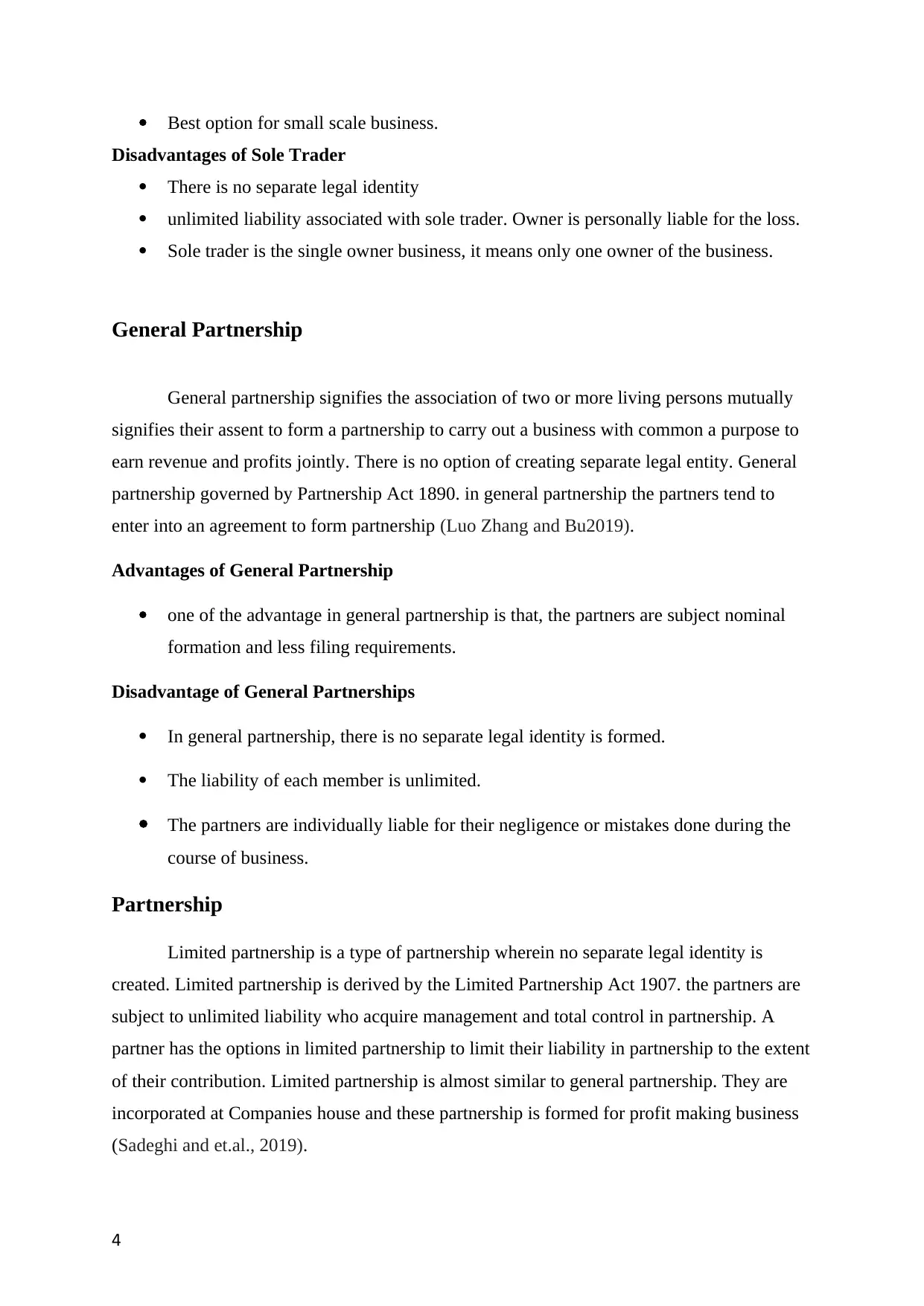
Best option for small scale business.
Disadvantages of Sole Trader
There is no separate legal identity
unlimited liability associated with sole trader. Owner is personally liable for the loss.
Sole trader is the single owner business, it means only one owner of the business.
General Partnership
General partnership signifies the association of two or more living persons mutually
signifies their assent to form a partnership to carry out a business with common a purpose to
earn revenue and profits jointly. There is no option of creating separate legal entity. General
partnership governed by Partnership Act 1890. in general partnership the partners tend to
enter into an agreement to form partnership (Luo Zhang and Bu2019).
Advantages of General Partnership
one of the advantage in general partnership is that, the partners are subject nominal
formation and less filing requirements.
Disadvantage of General Partnerships
In general partnership, there is no separate legal identity is formed.
The liability of each member is unlimited.
The partners are individually liable for their negligence or mistakes done during the
course of business.
Partnership
Limited partnership is a type of partnership wherein no separate legal identity is
created. Limited partnership is derived by the Limited Partnership Act 1907. the partners are
subject to unlimited liability who acquire management and total control in partnership. A
partner has the options in limited partnership to limit their liability in partnership to the extent
of their contribution. Limited partnership is almost similar to general partnership. They are
incorporated at Companies house and these partnership is formed for profit making business
(Sadeghi and et.al., 2019).
4
Disadvantages of Sole Trader
There is no separate legal identity
unlimited liability associated with sole trader. Owner is personally liable for the loss.
Sole trader is the single owner business, it means only one owner of the business.
General Partnership
General partnership signifies the association of two or more living persons mutually
signifies their assent to form a partnership to carry out a business with common a purpose to
earn revenue and profits jointly. There is no option of creating separate legal entity. General
partnership governed by Partnership Act 1890. in general partnership the partners tend to
enter into an agreement to form partnership (Luo Zhang and Bu2019).
Advantages of General Partnership
one of the advantage in general partnership is that, the partners are subject nominal
formation and less filing requirements.
Disadvantage of General Partnerships
In general partnership, there is no separate legal identity is formed.
The liability of each member is unlimited.
The partners are individually liable for their negligence or mistakes done during the
course of business.
Partnership
Limited partnership is a type of partnership wherein no separate legal identity is
created. Limited partnership is derived by the Limited Partnership Act 1907. the partners are
subject to unlimited liability who acquire management and total control in partnership. A
partner has the options in limited partnership to limit their liability in partnership to the extent
of their contribution. Limited partnership is almost similar to general partnership. They are
incorporated at Companies house and these partnership is formed for profit making business
(Sadeghi and et.al., 2019).
4
Paraphrase This Document
Need a fresh take? Get an instant paraphrase of this document with our AI Paraphraser
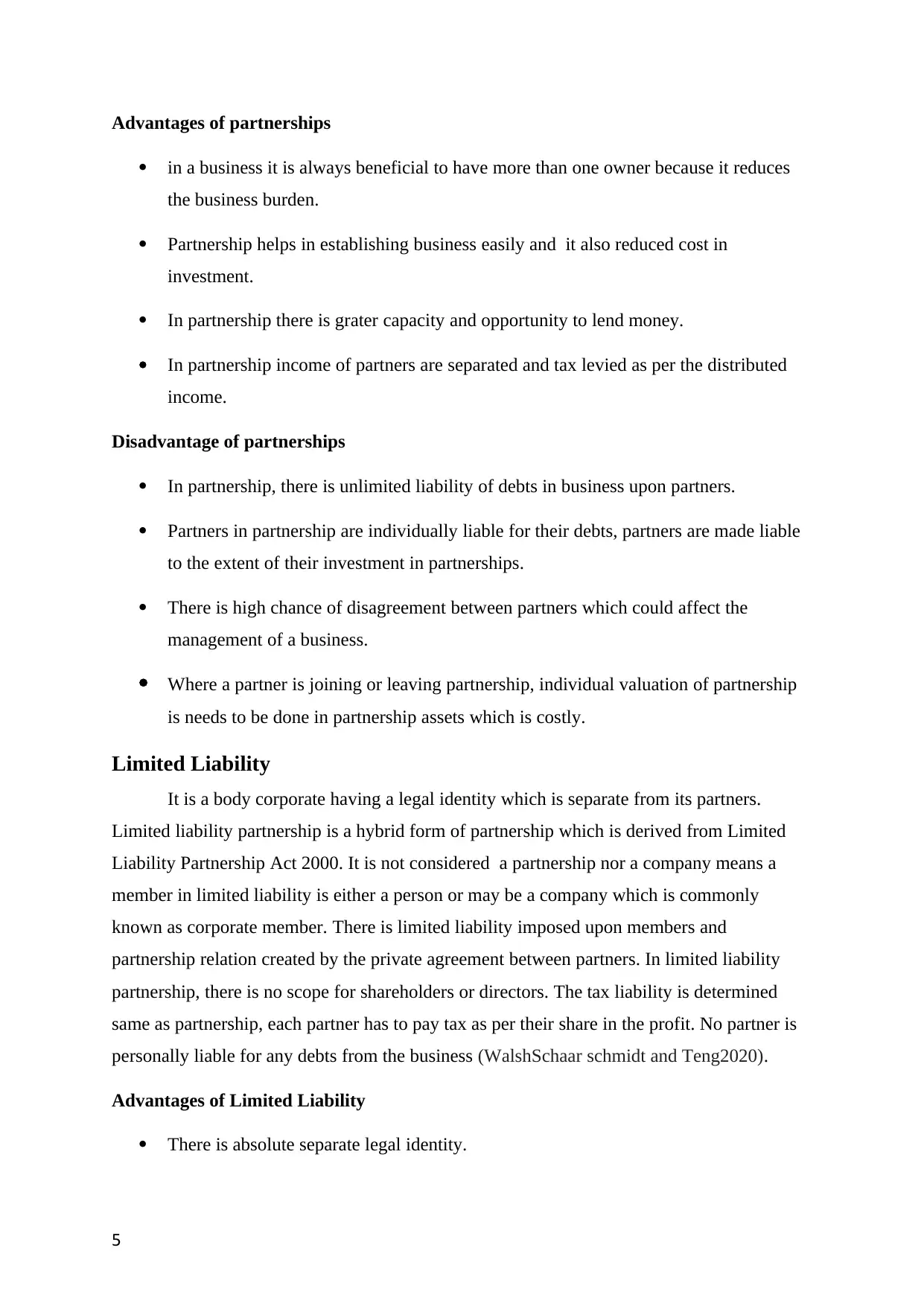
Advantages of partnerships
in a business it is always beneficial to have more than one owner because it reduces
the business burden.
Partnership helps in establishing business easily and it also reduced cost in
investment.
In partnership there is grater capacity and opportunity to lend money.
In partnership income of partners are separated and tax levied as per the distributed
income.
Disadvantage of partnerships
In partnership, there is unlimited liability of debts in business upon partners.
Partners in partnership are individually liable for their debts, partners are made liable
to the extent of their investment in partnerships.
There is high chance of disagreement between partners which could affect the
management of a business.
Where a partner is joining or leaving partnership, individual valuation of partnership
is needs to be done in partnership assets which is costly.
Limited Liability
It is a body corporate having a legal identity which is separate from its partners.
Limited liability partnership is a hybrid form of partnership which is derived from Limited
Liability Partnership Act 2000. It is not considered a partnership nor a company means a
member in limited liability is either a person or may be a company which is commonly
known as corporate member. There is limited liability imposed upon members and
partnership relation created by the private agreement between partners. In limited liability
partnership, there is no scope for shareholders or directors. The tax liability is determined
same as partnership, each partner has to pay tax as per their share in the profit. No partner is
personally liable for any debts from the business (WalshSchaar schmidt and Teng2020).
Advantages of Limited Liability
There is absolute separate legal identity.
5
in a business it is always beneficial to have more than one owner because it reduces
the business burden.
Partnership helps in establishing business easily and it also reduced cost in
investment.
In partnership there is grater capacity and opportunity to lend money.
In partnership income of partners are separated and tax levied as per the distributed
income.
Disadvantage of partnerships
In partnership, there is unlimited liability of debts in business upon partners.
Partners in partnership are individually liable for their debts, partners are made liable
to the extent of their investment in partnerships.
There is high chance of disagreement between partners which could affect the
management of a business.
Where a partner is joining or leaving partnership, individual valuation of partnership
is needs to be done in partnership assets which is costly.
Limited Liability
It is a body corporate having a legal identity which is separate from its partners.
Limited liability partnership is a hybrid form of partnership which is derived from Limited
Liability Partnership Act 2000. It is not considered a partnership nor a company means a
member in limited liability is either a person or may be a company which is commonly
known as corporate member. There is limited liability imposed upon members and
partnership relation created by the private agreement between partners. In limited liability
partnership, there is no scope for shareholders or directors. The tax liability is determined
same as partnership, each partner has to pay tax as per their share in the profit. No partner is
personally liable for any debts from the business (WalshSchaar schmidt and Teng2020).
Advantages of Limited Liability
There is absolute separate legal identity.
5
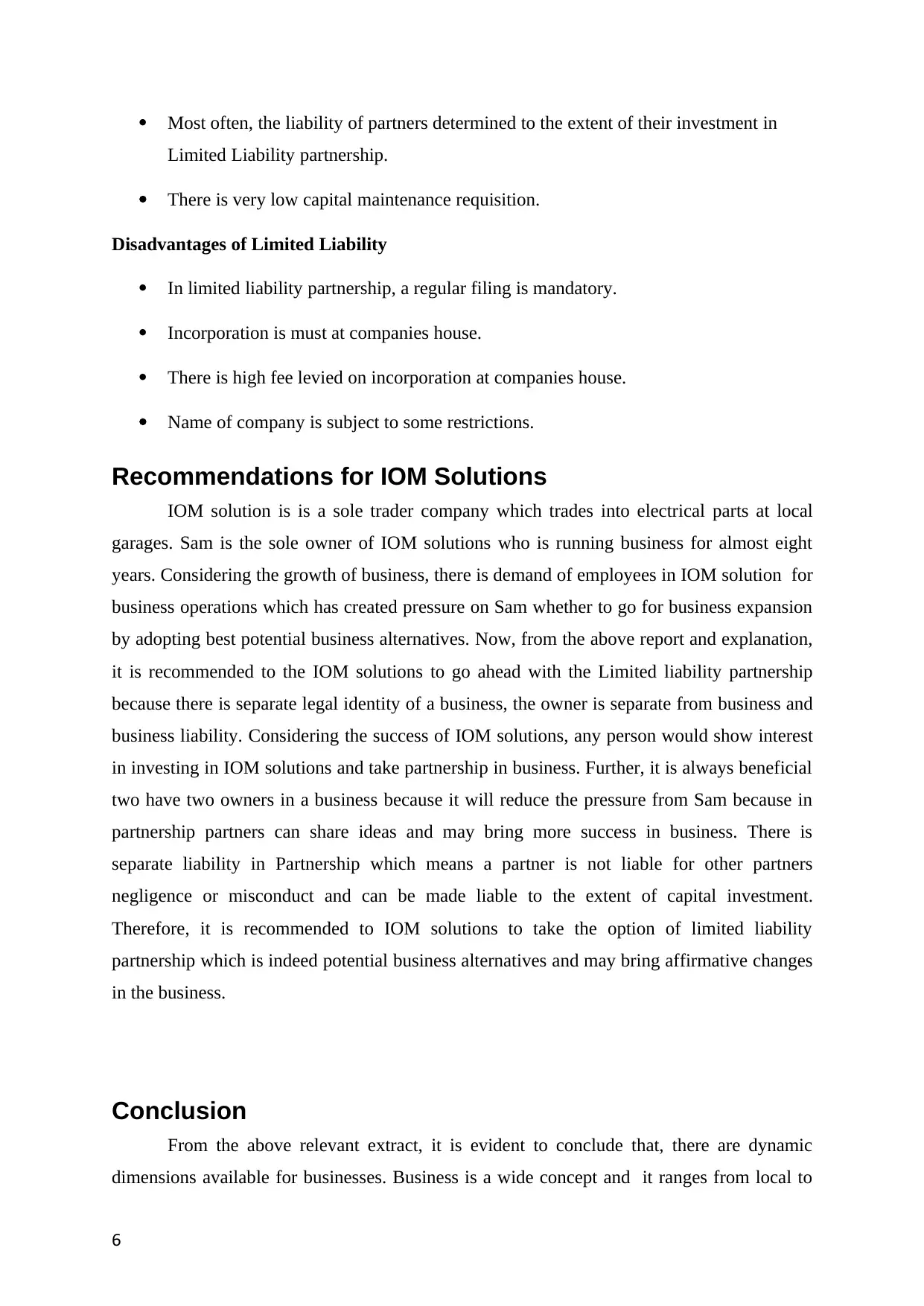
Most often, the liability of partners determined to the extent of their investment in
Limited Liability partnership.
There is very low capital maintenance requisition.
Disadvantages of Limited Liability
In limited liability partnership, a regular filing is mandatory.
Incorporation is must at companies house.
There is high fee levied on incorporation at companies house.
Name of company is subject to some restrictions.
Recommendations for IOM Solutions
IOM solution is is a sole trader company which trades into electrical parts at local
garages. Sam is the sole owner of IOM solutions who is running business for almost eight
years. Considering the growth of business, there is demand of employees in IOM solution for
business operations which has created pressure on Sam whether to go for business expansion
by adopting best potential business alternatives. Now, from the above report and explanation,
it is recommended to the IOM solutions to go ahead with the Limited liability partnership
because there is separate legal identity of a business, the owner is separate from business and
business liability. Considering the success of IOM solutions, any person would show interest
in investing in IOM solutions and take partnership in business. Further, it is always beneficial
two have two owners in a business because it will reduce the pressure from Sam because in
partnership partners can share ideas and may bring more success in business. There is
separate liability in Partnership which means a partner is not liable for other partners
negligence or misconduct and can be made liable to the extent of capital investment.
Therefore, it is recommended to IOM solutions to take the option of limited liability
partnership which is indeed potential business alternatives and may bring affirmative changes
in the business.
Conclusion
From the above relevant extract, it is evident to conclude that, there are dynamic
dimensions available for businesses. Business is a wide concept and it ranges from local to
6
Limited Liability partnership.
There is very low capital maintenance requisition.
Disadvantages of Limited Liability
In limited liability partnership, a regular filing is mandatory.
Incorporation is must at companies house.
There is high fee levied on incorporation at companies house.
Name of company is subject to some restrictions.
Recommendations for IOM Solutions
IOM solution is is a sole trader company which trades into electrical parts at local
garages. Sam is the sole owner of IOM solutions who is running business for almost eight
years. Considering the growth of business, there is demand of employees in IOM solution for
business operations which has created pressure on Sam whether to go for business expansion
by adopting best potential business alternatives. Now, from the above report and explanation,
it is recommended to the IOM solutions to go ahead with the Limited liability partnership
because there is separate legal identity of a business, the owner is separate from business and
business liability. Considering the success of IOM solutions, any person would show interest
in investing in IOM solutions and take partnership in business. Further, it is always beneficial
two have two owners in a business because it will reduce the pressure from Sam because in
partnership partners can share ideas and may bring more success in business. There is
separate liability in Partnership which means a partner is not liable for other partners
negligence or misconduct and can be made liable to the extent of capital investment.
Therefore, it is recommended to IOM solutions to take the option of limited liability
partnership which is indeed potential business alternatives and may bring affirmative changes
in the business.
Conclusion
From the above relevant extract, it is evident to conclude that, there are dynamic
dimensions available for businesses. Business is a wide concept and it ranges from local to
6
⊘ This is a preview!⊘
Do you want full access?
Subscribe today to unlock all pages.

Trusted by 1+ million students worldwide
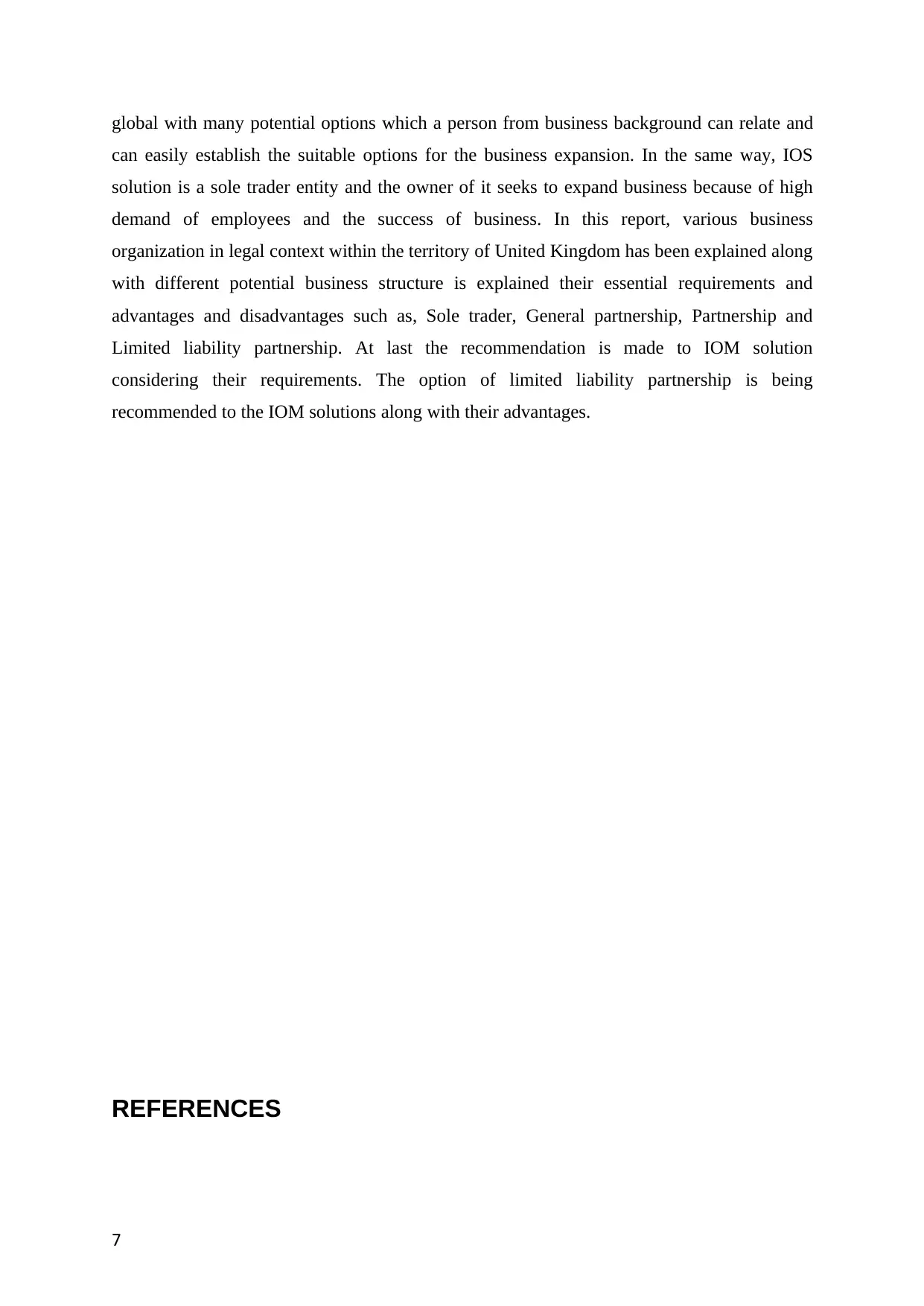
global with many potential options which a person from business background can relate and
can easily establish the suitable options for the business expansion. In the same way, IOS
solution is a sole trader entity and the owner of it seeks to expand business because of high
demand of employees and the success of business. In this report, various business
organization in legal context within the territory of United Kingdom has been explained along
with different potential business structure is explained their essential requirements and
advantages and disadvantages such as, Sole trader, General partnership, Partnership and
Limited liability partnership. At last the recommendation is made to IOM solution
considering their requirements. The option of limited liability partnership is being
recommended to the IOM solutions along with their advantages.
REFERENCES
7
can easily establish the suitable options for the business expansion. In the same way, IOS
solution is a sole trader entity and the owner of it seeks to expand business because of high
demand of employees and the success of business. In this report, various business
organization in legal context within the territory of United Kingdom has been explained along
with different potential business structure is explained their essential requirements and
advantages and disadvantages such as, Sole trader, General partnership, Partnership and
Limited liability partnership. At last the recommendation is made to IOM solution
considering their requirements. The option of limited liability partnership is being
recommended to the IOM solutions along with their advantages.
REFERENCES
7
Paraphrase This Document
Need a fresh take? Get an instant paraphrase of this document with our AI Paraphraser
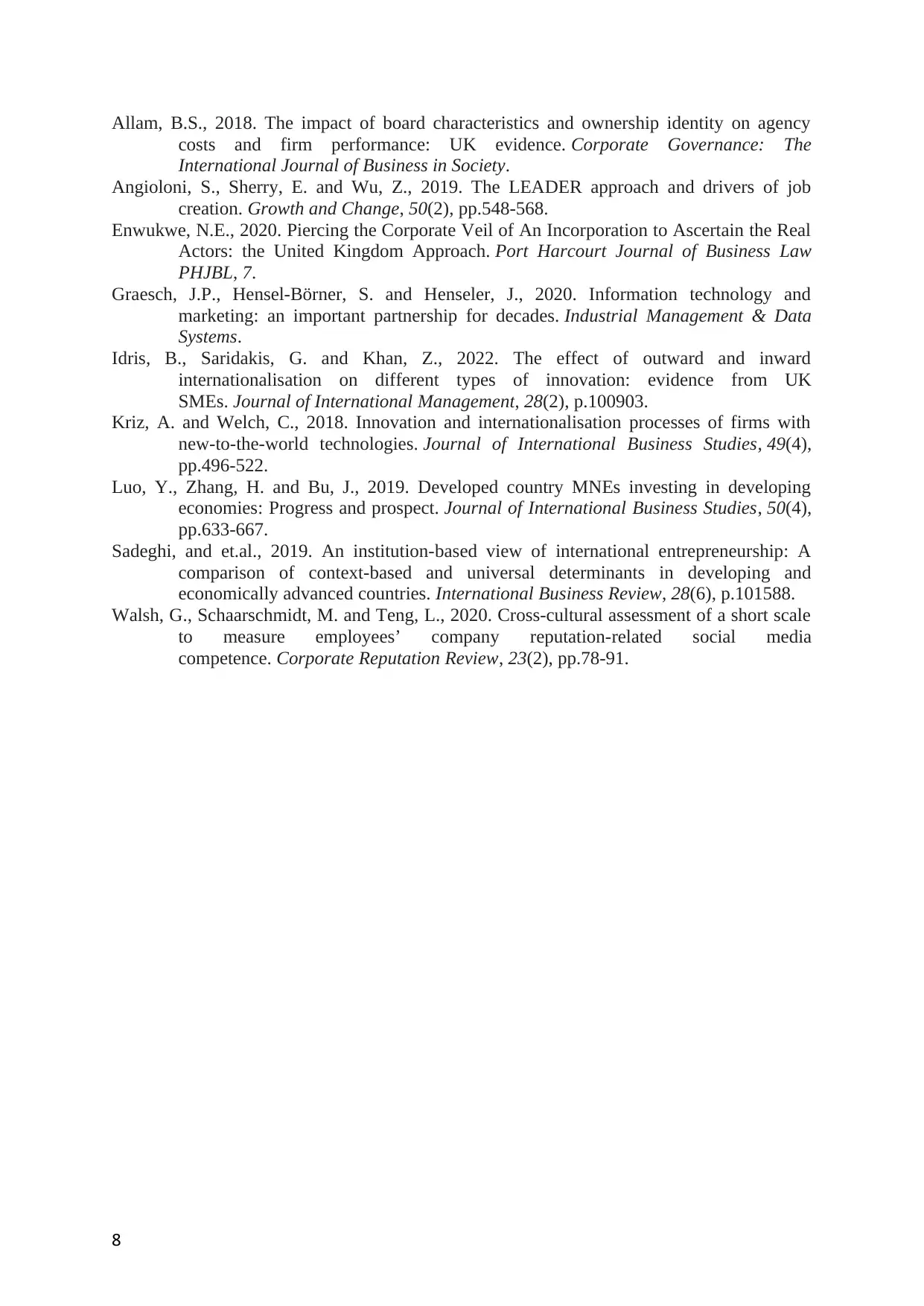
Allam, B.S., 2018. The impact of board characteristics and ownership identity on agency
costs and firm performance: UK evidence. Corporate Governance: The
International Journal of Business in Society.
Angioloni, S., Sherry, E. and Wu, Z., 2019. The LEADER approach and drivers of job
creation. Growth and Change, 50(2), pp.548-568.
Enwukwe, N.E., 2020. Piercing the Corporate Veil of An Incorporation to Ascertain the Real
Actors: the United Kingdom Approach. Port Harcourt Journal of Business Law
PHJBL, 7.
Graesch, J.P., Hensel-Börner, S. and Henseler, J., 2020. Information technology and
marketing: an important partnership for decades. Industrial Management & Data
Systems.
Idris, B., Saridakis, G. and Khan, Z., 2022. The effect of outward and inward
internationalisation on different types of innovation: evidence from UK
SMEs. Journal of International Management, 28(2), p.100903.
Kriz, A. and Welch, C., 2018. Innovation and internationalisation processes of firms with
new-to-the-world technologies. Journal of International Business Studies, 49(4),
pp.496-522.
Luo, Y., Zhang, H. and Bu, J., 2019. Developed country MNEs investing in developing
economies: Progress and prospect. Journal of International Business Studies, 50(4),
pp.633-667.
Sadeghi, and et.al., 2019. An institution-based view of international entrepreneurship: A
comparison of context-based and universal determinants in developing and
economically advanced countries. International Business Review, 28(6), p.101588.
Walsh, G., Schaarschmidt, M. and Teng, L., 2020. Cross-cultural assessment of a short scale
to measure employees’ company reputation-related social media
competence. Corporate Reputation Review, 23(2), pp.78-91.
8
costs and firm performance: UK evidence. Corporate Governance: The
International Journal of Business in Society.
Angioloni, S., Sherry, E. and Wu, Z., 2019. The LEADER approach and drivers of job
creation. Growth and Change, 50(2), pp.548-568.
Enwukwe, N.E., 2020. Piercing the Corporate Veil of An Incorporation to Ascertain the Real
Actors: the United Kingdom Approach. Port Harcourt Journal of Business Law
PHJBL, 7.
Graesch, J.P., Hensel-Börner, S. and Henseler, J., 2020. Information technology and
marketing: an important partnership for decades. Industrial Management & Data
Systems.
Idris, B., Saridakis, G. and Khan, Z., 2022. The effect of outward and inward
internationalisation on different types of innovation: evidence from UK
SMEs. Journal of International Management, 28(2), p.100903.
Kriz, A. and Welch, C., 2018. Innovation and internationalisation processes of firms with
new-to-the-world technologies. Journal of International Business Studies, 49(4),
pp.496-522.
Luo, Y., Zhang, H. and Bu, J., 2019. Developed country MNEs investing in developing
economies: Progress and prospect. Journal of International Business Studies, 50(4),
pp.633-667.
Sadeghi, and et.al., 2019. An institution-based view of international entrepreneurship: A
comparison of context-based and universal determinants in developing and
economically advanced countries. International Business Review, 28(6), p.101588.
Walsh, G., Schaarschmidt, M. and Teng, L., 2020. Cross-cultural assessment of a short scale
to measure employees’ company reputation-related social media
competence. Corporate Reputation Review, 23(2), pp.78-91.
8
1 out of 8
Related Documents
Your All-in-One AI-Powered Toolkit for Academic Success.
+13062052269
info@desklib.com
Available 24*7 on WhatsApp / Email
![[object Object]](/_next/static/media/star-bottom.7253800d.svg)
Unlock your academic potential
Copyright © 2020–2025 A2Z Services. All Rights Reserved. Developed and managed by ZUCOL.
